Photographs: Vivek Prakash/Reuters Abhineet Kumar in Mumbai
The Indian Hotels Company's strategy of multiple brands has helped it expand into upscale segments, but it had to tackle transition challenges wherever old properties were given a new identity.
The 112-year-old Tata enterprise continued with its flagship brand, Taj, for over a century before it launched its upscale chain of hotels called Gateway in September 2008, and Vivanta by Taj two years later.
These were geared to grab the opportunities in upscale hotels, so much so that it divided the segment further into upper-upscale (Vivanta by Taj) and upscale (Gateway). With 76 properties, the brand name of Taj was getting over-stretched.
...
Tata's hotel chain juggles multiple brands
Image: Tata Group's Ginger chain in Ahmedabad.Photographs: Amit Dave/Reuters
The industry classifies hotels as luxury, upscale, mid-market and budget. According to estimates of the hospitality industry research firm HVS, branded hotels supply in India has increased to about 96,000 rooms in 2012-13, from 24,900 in 2000-01.
Luxury contributes 22 per cent, upscale 29 per cent, mid-market 34 per cent and budget 14 per cent to the industry's number of rooms.
The re-branding exercise became important for IHC when it decided to move into segments below luxury to maintain its market leadership, at a time when several Indian as well as global hotel chains went aggressive with multiple brands.
...
Tata's hotel chain juggles multiple brands
Image: Guests sit at poolside in the Taj Mahal hotel in Mumbai.Photographs: Punit Paranjpe/Reuters
IHC started the exercise with transferring about 16 properties to the Gateway brand. With new properties, the tally went up to 22 hotels. Similarly, it started the brand Vivanta by Taj by transferring 19 existing properties.
There are 25 hotels under its aegis.
"The challenge was how perfectly we would be able to deliver the Vivanta experience in hotels that have been migrated, as they were not built to product specifications," says Deepa Misra Harris, senior vice-president, sales and marketing, at the company.
Product specifications for Vivanta sport edgy designs and architectural perfection, making it all about detailing. Vivanta by Taj, Whitefield, Bangalore, a new addition, has a Mobius strip-like portico, in front of an exterior of cool, colour-changing glass.
...
Tata's hotel chain juggles multiple brands
Image: Historic Gateway of India is seen through the window of a room in Taj Mahal hotel in Mumbai.Photographs: Arko Datta/Reuters
Inside, high, ribbed wooden ceilings are supported on bare, concrete piloti. The surrounding landscape and water become statement features.
"For the old properties which took on the name of Vivanta, we are very stringent on the brand specs (specifications), which means that everything else but the product (the hotel structure) should really be consistent with the brand's identity," Harris says.
The first change noticed at these hotels after they assumed the new identity was a young staff, talking in a different lexicon, as the brand Vivanta by Taj was supposed to exude a much more informal air than the luxury Taj.
...
Tata's hotel chain juggles multiple brands
Image: A man looks out of his shop as the Taj Mahal hotel is reflected in the window in Mumbai.Photographs: Arko Datta/Reuters
The biggest challenge, the company says, was in training the staff to get used to the new ethos.
But there were existing customers, so the company fused the older hotel property name with the new branding, wherever its equity was high. So, Taj President, Mumbai, was re-branded as Vivanta by Taj - President, Mumbai.
There are about six such hotels which retain a semblance of their old names. The rest of them are identified by their location such as Vivanta by Taj - M G Road, Bangalore.
...
Tata's hotel chain juggles multiple brands
Image: A man plays the piano at the lobby of Taj Mahal hotel in Mumbai.Photographs: Arko Datta/Reuters
The bet to move into multiple brands has worked well for the company. The occupancy levels at Vivanta hotels, including the older structures, moved up to 68 per cent in 2010-11, after the new branding exercise, from 60 per cent the year before.
While it came down to 65 per cent in 2011-12 on the heels of the downturn, it moved back to 66 per cent in 2012-13, with the signs of revival in the economy. New properties additions too tend to skew the average.
...
Tata's hotel chain juggles multiple brands
Image: Employees of Taj Mahal hotel in Mumbai prepare 'Souk' restaurant.Photographs: Handout/Reuters
According to industry estimates, it takes three years for a new property to reach 50 per cent occupancy level, but even then, Vivanta hotels achieved this much earlier, in 12-15 months.
"There was this fear that with migrating properties we may lose occupancy and revenue but for the Vivanta hotels, it has gone up for sure," says Harris.
The company also claims to have a 13 per cent higher revenue-per-available-room (Rev-Par) than its peers, signifying the brand's acceptance that lets it command premium tariffs.
...
Tata's hotel chain juggles multiple brands
Image: Guests walk by the poolside area of Taj Mahal hotel in Mumbai.Photographs: Arko Datta/Reuters
Gateway is designed for the new-age business as well as leisure traveller who is looking for contemporary experience and value for money. Gateway Hotels are divided into eight zones - Enter, Stay, Hangout, Meet, Work, Workout, Unwind and Explore.
Taj says its food and beverages are the key differentiators. For instance, its menu includes active food which is rich in antioxidants, high-fibre, with low glycemic index for the health conscious.
The cost of building a room for Taj is Rs 1-1.5 crore (Rs 15 billion) excluding the value of land, while the same for a Vivanta and Gateway room is Rs 85 lakh-1 crore and Rs 40 lakh, respectively.
...
Tata's hotel chain juggles multiple brands
Image: Employees of Taj Mahal hotel in Mumbai at the reception counter.Photographs: Arko Datta/Reuters
However, despite its ambitious expansion plans, the Taj group is conspicuously absent from the mid-market segment, which is likely to be the biggest demand driver in the coming years. It is expected to bring in 36 per cent of the industry's inventory in five years.
IHC cannot afford to ignore this segment for long if it is to retain its market share, observers say.
"As the new opportunity came below the luxury brand, it was imperative for IHC to come up with a multi-brands strategy," says Kaushik Vardharajan, managing director at HVS India.
"But the expansion in all the segments with the use Taj brands name would have diluted its equity."

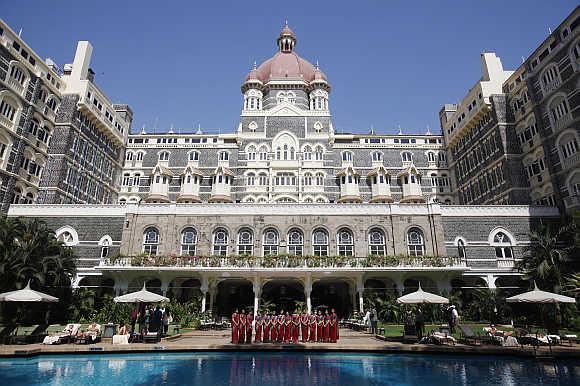
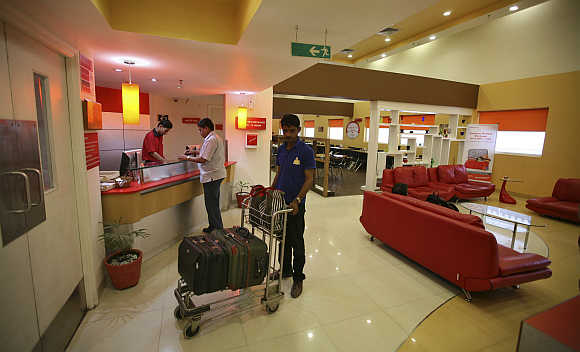
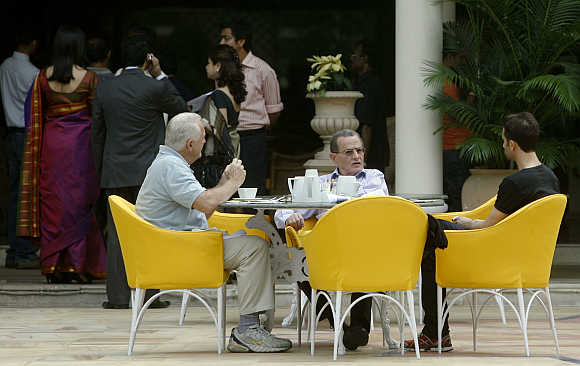


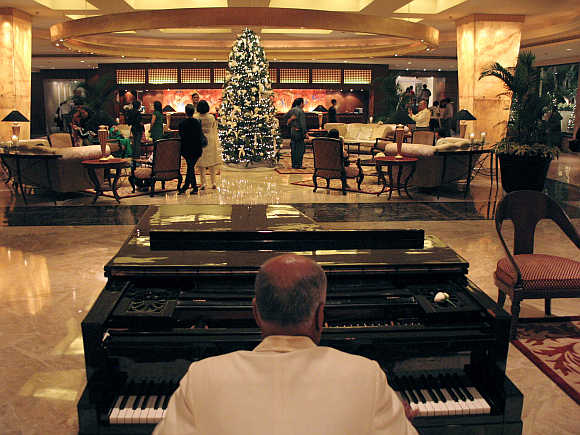


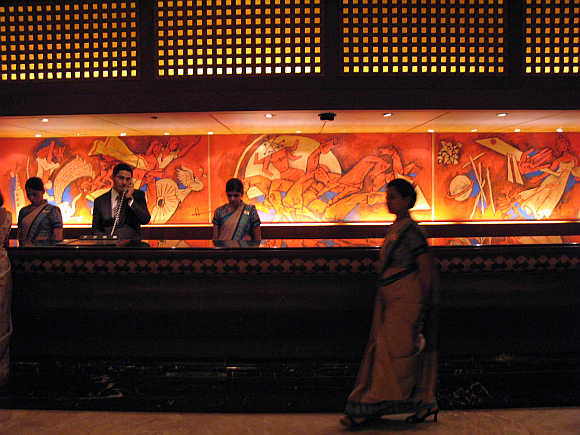

article